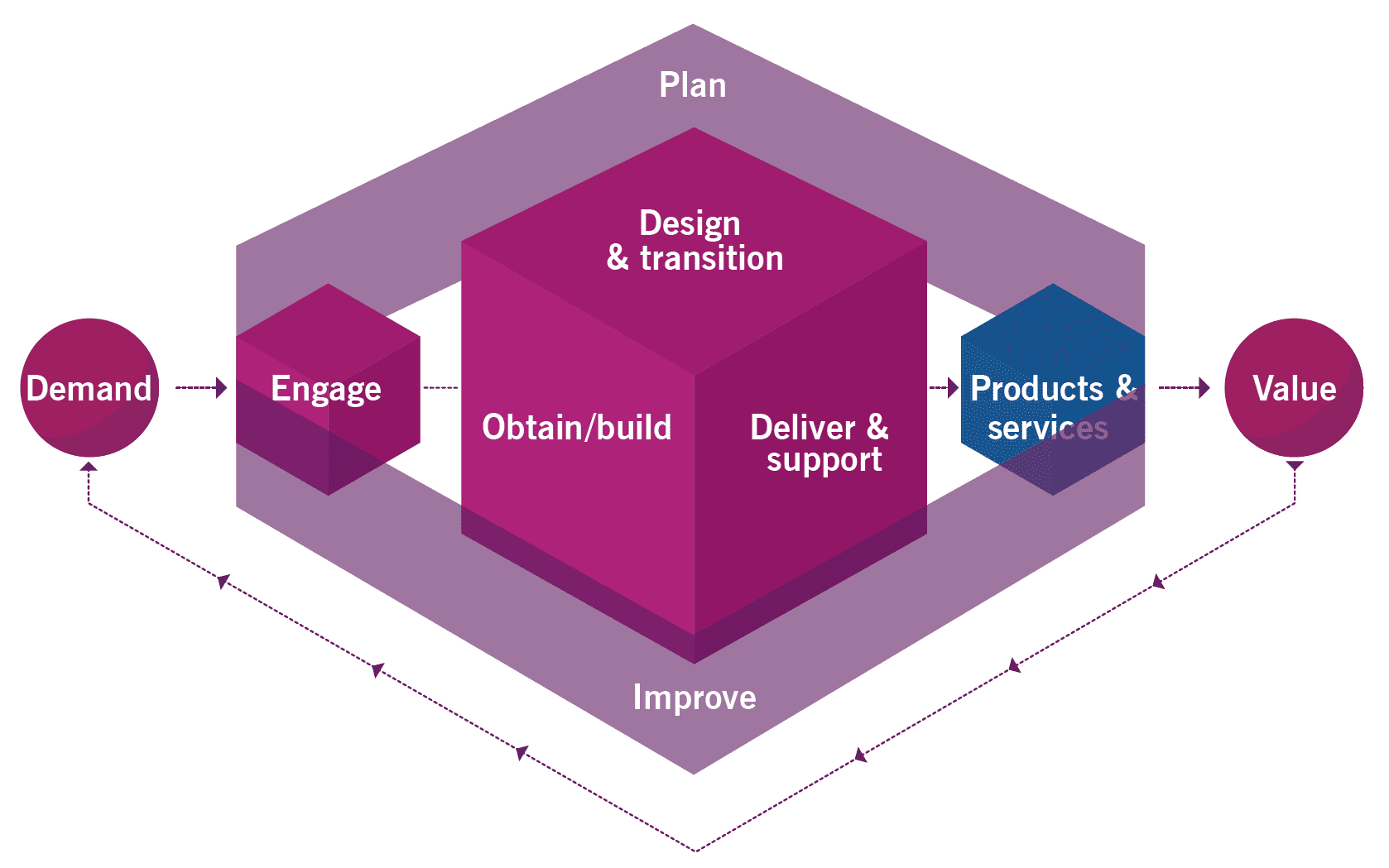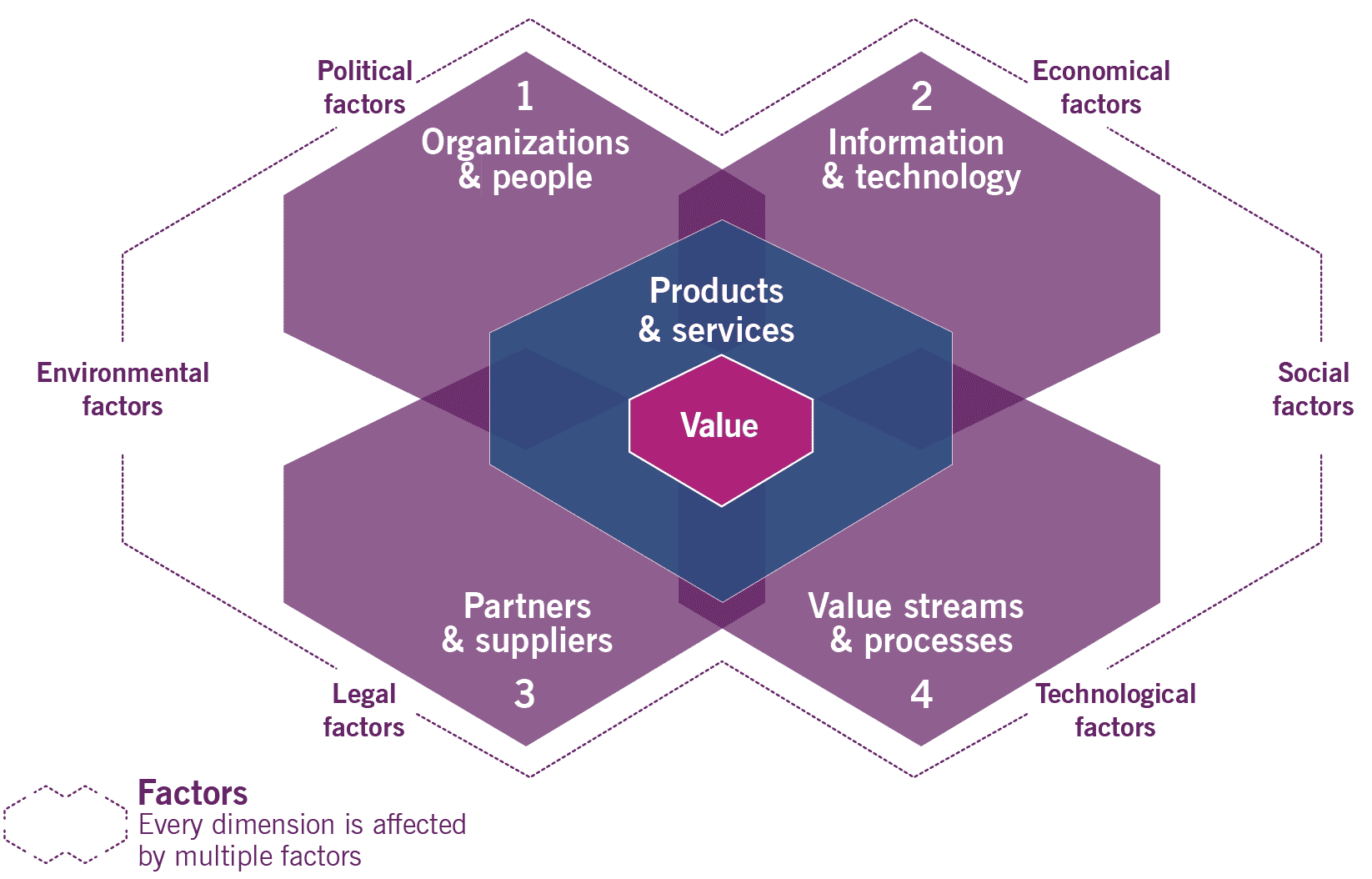ITIL 4
Everything you need to know about the latest ITIL service management best practice
09 mins read
The ITIL body of IT service management (ITSM) best practice guidance is a stalwart of the IT industry. Formerly known as the IT Infrastructure Library, the ITIL ITSM framework has undergone many changes over the last thirty years. This article explains what the latest version of ITIL (ITIL 4) includes, along with some of the key differences between the previous and new versions.
What is ITIL 4?
In early 2019, the previous version of ITIL, ITIL 2011 (now known as ITIL v3 2011 Edition), was updated to ITIL 4. Please note that this is ITIL 4, not ITIL v4, although some of the ITIL guidance found online is mistakenly called ITIL v4.
Describing what ITIL 4 is needs to start with a definition of what ITIL is, along with a little history.
Axelos, the owner of ITIL, defines it as "...the most widely recognized framework for IT and digitally enabled services in the world." Adding that "It provides comprehensive, practical and proven guidance for establishing an effective service management system."
However, before the update in 2019, ITIL was previously branded as ITSM best practice and often described as the most popular ITSM best practice framework. This definition changed because ITIL 4 was written to be applied outside of IT, too (unlike ITIL v3 2011 Edition).
The ITIL framework of ITSM best practice has undergone several changes since its origin in 1989 when the UK Government wanted a solution to its IT-project-related issues. Having grown in popularity globally, the second version was published in 2001 (ITIL v2), and its adoption increased rapidly. Some would argue on the back of ITSM tool adoption because the ITIL tools were ITIL aligned, often using ITIL as a blueprint for their ITSM-enabling capabilities.
2007 saw the publication of the third version, ITIL v3. However, ITIL v3 was "refreshed" in 2011 and renamed ITIL 2011. ITIL v3 was 2.5x the size of ITIL v2 with 26 processes (versus the ten in ITIL v2) split across five elements of the ITIL "service lifecycle":
- Service strategy
- Service design
- Service transition
- Service operation
- Continual service improvement (CSI).
How ITIL 4 changed ITIL 2011
ITIL 4 was a complete reimagining of the ITIL v3 2011 Edition ITIL framework, although the management practices used and updated any ITIL v3 content that was still valid. This change reflected how IT management and the technology landscape had changed since ITIL v3 2011 Edition.
The key differences between ITIL 4 and ITIL v3 2011 Edition include:
- A new focus on business value creation (or value co-creation) as the purpose of service management
- The move from the guidance relating to ITSM to service management
- The introduction of a service value system and service value chain
- The move from ITIL v3 2011 Edition's process-based structure to management practices
- The inclusion of ITIL guiding principles
- ITIL v3 2011 Edition's four Ps - people, processes, product (technology, and partners - are replaced with the four dimensions of service management
- The ITIL "service lifecycle" is no longer included (but can be replicated using the service value chain).
The ITIL 4 framework
ITIL has traditionally been called an ITSM framework, which means that ITIL 4 is now often called the ITIL service management framework (reflecting ITIL's move from ITSM to service management) or ITIL 4 framework. This is based on the ITIL 4 service value system (SVS), explained next.
The ITIL 4 service value system
The ITIL 4 Foundation publication states that the ITIL 4 service value system "...describes how all the components and activities of the organization work together as a system to enable value creation. Each organization's service value system has interfaces with other organizations, forming an ecosystem that can, in turn, facilitate value for those organizations, their customers, and other stakeholders."
The ITIL 4 Service Value System

The ITIL 4 service value system shows how service providers (IT or otherwise) turn stakeholder demand (on the left) into value (on the right) by using the five elements within the ITIL 4 service value system:
- The ITIL guiding principles
- Governance
- The ITIL 4 service value chain
- Management practices
- Continual improvement.
Three of these service value system elements - the ITIL 4 service value chain, the ITIL guiding principles, and management practices - are covered in more detail below. The other two elements are:
- Governance - for which ITIL 4 covers three key aspects:
- The evaluation of change
- Direction
- Monitoring of organizational performance
- Continual improvement - this replaces the ITIL v3 2011 Edition's CSI. There are two key changes:
- The name and guidance changes reflect that continual improvement applies to more than service improvement
- Continual improvement is a management practice rather than a separate ITIL v3 2011 Edition publication.
The ITIL 4 service value chain
Axelos states that "The central element of the service value system is the service value chain, an operating model which outlines the key activities required to respond to demand and facilitate value realization through the creation and management of products and services."
The ITIL 4 Service Value Chain

The ITIL 4 service value chain contains six repeatable value chain activities:
- Plan - gaining a shared understanding of service provision and support aspects
- Improve -continually improving service management practices, products, and services
- Engage - understanding stakeholder needs and creating good relationships
- Design and transition - ensuring products and services meet customer expectations related to quality, cost, and time-to-market
- Obtain/build - ensuring service-component availability for service delivery
- Deliver and support - ensuring service delivery and support capabilities meet the agreed specifications and expectations.
ITIL 4 states, "These service value chain activities in the ITIL 4 service value system represent the steps an organization takes in the creation of value. Each activity transforms inputs into outputs. These inputs can be demand from outside the value chain or outputs of other activities. All the activities are interconnected, with each activity receiving and providing triggers for further action."
The ITIL 4 guiding principles
ITIL guiding principles were introduced in the 2016 ITIL Practitioner Guidance book, where there were nine rather than seven. ITIL 4 describes a guiding principle as a "...recommendation that guides an organization in all circumstances, regardless of changes in its goals, strategies, type of work, or management structure." The guiding principles are intended to guide organizations as they adopt and adapt the ITIL 4 framework based on their needs and circumstances.
The seven ITIL 4 guiding principles are:
- Focus on value - "Everything that the organization does needs to map, directly or indirectly, to value for the stakeholders."
- Start where you are - "Do not start from scratch and build something new without considering what is already available to be leveraged."
- Progress iteratively with feedback - "Do not attempt to do everything at once. Even huge initiatives must be accomplished iteratively."
- Collaborate and promote visibility - "Working together across boundaries produces results that have greater buy-in, more relevance to objectives, and increased likelihood of long-term success."
- Think and work holistically - "No service, or element used to provide a service, stands alone. The outcomes achieved by the service provider and service consumer will suffer unless the organization works on the service as a whole, not just on its parts."
- Keep it simple and practical - "If a process, service, action or metric fails to provide value or produce a useful outcome, eliminate it."
- Optimize and automate - "Resources of all types, particularly human resources, should be used to their best effect. Eliminate anything that is truly wasteful and use technology to achieve whatever it is capable of."
All of these abbreviated guiding principle definitions are from the ITIL 4 publications.
ITIL 4 dimensions - the 4 dimensions of service management
The ITIL 4 framework defines four dimensions critical to value creation. The focus must be applied to each dimension for the ITIL 4 service value system to be balanced and effective:
- Organizations and people - the corporate culture must support the organization's objectives; there needs to be the right staff capacity and competency levels
- Information and technology - the information, knowledge, and technologies needed for the effective management of services
- Partners and suppliers - the suppliers involved in designing, deploying, delivering, supporting, and continually improving services and the associated relationships.
- Value streams and processes - value creation is adversely affected if different parts of the organization don't work in an integrated and coordinated way.
The Four Dimensions of Service Management

The four dimensions of service management approach helps organizations ensure a balanced focus on all the elements needed for successful service management (including ITSM).
The ITIL 4 practices
Axelos defines a management practice as "...a set of organizational resources designed for performing work or accomplishing an objective." There are three types of management practice:
- General management practices - "adopted and adapted for service management from general business management domains"
- Service management practices - developed in service management and ITSM industries.
- Technical management practices - "adapted from technology management domains for service management purposes."
The 34 ITIL 4 management practices are split into these three types of practice:
General Management Practices
- Architecture management
- Continual improvement
- Information security management
- Knowledge management
- Measurement and reporting
- Organizational change management
- Portfolio management
- Project management
- Relationship management
- Risk management
- Service financial management
- Strategy management
- Supplier management
- Workforce and talent management
Service Management Practices
- Availability management
- Business analysis
- Capacity and performance management
- Change enablement
- Incident management
- IT asset management
- Monitoring and event management
- Problem management
- Release management
- Service catalog management
- Service configuration management
- Service continuity management
- Service design
- Service desk
- Service level management
- Service request management
- Service validation and testing
Technical Management Practices
- Deployment management
- Infrastructure and platform management
- Software development and management
The ITIL 4 processes
For many people, the previous versions of ITIL were all about the ITIL processes. While ITIL 4 moved the ITIL v3 2011 Edition from processes to practices, it still includes examples of ITIL process flows within its practices. For example:
- The incident management practice consists of two processes - incident handling and resolution, and periodic incident review
- The change enablement practice includes two processes - change enablement planning and optimization, and change lifecycle management
- The problem management practice consists of four processes - proactive problem identification, reactive problem identification, problem control, and error control.
- The service desk practice includes three processes - user query handling, communicating to users, and service desk optimization.
For each process, ITIL 4 offers guidance related to the process Inputs, activities, and outputs.
ITIL 4 Certifications
The ITIL 4 Foundation publication and certification were both released in 2019. The following year brought three higher-level certifications and the supporting content:
- ITIL Managing Professional
- ITIL Strategic Leader
- ITIL Master.
The core training modules for the certifications are:
- ITIL Foundation
- ITIL Managing Professional
- Create, Deliver & Support
- Drive Stakeholder Value
- High Velocity IT
- Direct, Plan & Improve
- ITIL Strategic Leader
- Direct, Plan & Improve
- Digital & IT Strategy.
The ITIL Master status is achieved by completing all the Managing Professional and Strategic Leader modules and demonstrating at least five years' experience in service management leadership, management, or management advisory roles. This certification was called ITIL Expert in the ITIL v3 2011 Edition.
Four ITIL 4 Specialist "extension modules" have since been added to these core certifications:
- Acquiring & Managing Cloud Services
- Business Relationship Management
- IT Asset Management
- Sustainability in Digital & IT.
Finally, the ITIL Practice Manager certification was added in 2023. It offers ITIL 4 Foundation certification holders a different progression path, allowing them to obtain a focused manager-level ITIL 4 certification in one of three areas:
- Monitor, Support and Fulfil - incident management, monitoring and event management, problem management, service desk, and service request management.
- Plan, Implement and Control - change enablement, deployment management, IT asset management, release management, and service configuration management.
- Collaborate, Assure and Improve - continual improvement, information security management, relationship management, service level management, and supplier management.

